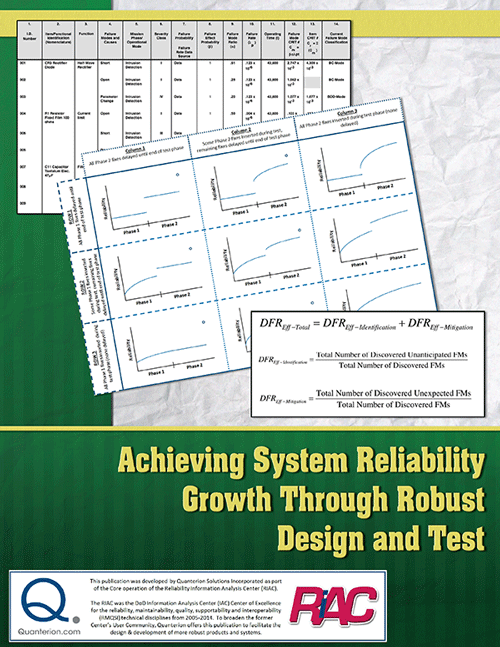| 1. INTRODUCTION |
1 |
| 1.1 EMPHASIS ON PRACTICAL APPLICATION |
1 |
| 1.2 RELIABILITY GROWTH IN DESIGN VS TEST |
2 |
| 1.3 COMPANION/SUPPLEMENT TO MIL-HDBK-189A |
3 |
| 2. DEFINITIONS |
5 |
| 3. RELIABILITY GROWTH-RELATED POLICIES, STANDARDS AND HANDBOOKS |
13 |
| 3.1 WEAPON SYSTEM ACQUISITION REFORM ACT (WSARA) |
13 |
| 3.2 DODI INSTRUCTION 5000.02 |
15 |
| 3.3 DEFENSE TECHNICAL MEMORANDUM (DTM) 11-003 |
17 |
| 3.4 ANSI/GEIA-STD-0009 |
18 |
| 3.4.1 Identification of Failure Modes and Mechanisms |
20 |
| 3.4.2 Closed-Loop Failure Mode Mitigation Process |
22 |
| 3.5 MIL-HDBK-189A |
24 |
| 3.5.1 Reliability Growth Planning |
24 |
| 3.5.2 Reliability Tracking |
25 |
| 3.5.3 Reliability Projection |
25 |
| 4. THE CONCEPT OF RELIABILITY GROWTH |
27 |
| 4.2 RELIABILITY GROWTH MANAGEMENT |
29 |
| 4.3 TOTAL LIFE CYCLE COST CONSIDERATIONS |
33 |
| 4.4 THE RELIABILITY GROWTH PROCESS |
47 |
| 4.4.1 Type A and Type B Failure Modes |
47 |
| 4.4.2 Achieving Growth |
48 |
| 4.4.3 Attaining the Requirement |
48 |
| 4.4.4 Growth Rate |
48 |
| 4.4.5 Reliability Growth Management Control Processes |
49 |
| 4.5 RELIABILITY GROWTH DURING DESIGN |
57 |
| 4.6 RELIABILITY GROWTH DURING TESTING |
60 |
| 4.7 RELIABILITY GROWTH DURING MANUFACTURING |
62 |
| 4.8 RELIABILITY GROWTH DURING OPERATION AND SUPPORT |
64 |
| 5. RELIABILITY GROWTH METHODS |
67 |
| 5.1 DESIGN |
67 |
| 5.1.1 Failure Modes and Effects Analysis (FMEA)/Failure Modes, Effects and Criticality Analysis (FMECA) |
67 |
| 5.1.2 Fault Tree Analysis (FTA) |
101 |
| 5.1.3 Reliability Physics (Physics-of-Failure (PoF)) |
114 |
| 5.1.4 Design of Experiments (DOE) |
129 |
| 5.1.5 Accelerated and Highly Accelerated Testing |
139 |
| 5.1.6 Sneak Analysis |
146 |
| 5.1.7 Reliability Centered Maintenance (RCM) |
155 |
| 5.1.8 Orthogonal Defect Classification for Software |
164 |
| 5.1.9 The Role of Unanticipated and Unexpected Failure Modes in Design Reliability Growth |
170 |
| 5.2 TEST |
172 |
| 5.2.1 Test-Fix-Test |
177 |
| 5.2.2 Test-Find-Test |
178 |
| 5.2.3 Test-Fix-Test with Delayed Fixes (including Test-Fix-Find-Test) |
182 |
| 5.2.4 Combined Influence of Factors on Reliability Growth Curve Shapes |
183 |
| 5.2.5 Software Reliability Growth |
184 |
| 5.2.6 FRACAS |
188 |
| 5.2.7 The Role of Unanticipated and Unexpected Failure Modes in Reliability Growth During Testing |
200 |
| 5.3 MANUFACTURING PROCESSES |
201 |
| 5.3.1 Statistical Process Control and Six-Sigma Processes |
201 |
| 5.3.2 The Role of Unanticipated and Unexpected Failure Modes in Manufacturing Process Reliability Growth |
214 |
| 5.4 OPERATION AND SUPPORT |
217 |
| 5.4.1 Repair Strategy |
217 |
| 5.4.2 Data Collection and Analysis |
218 |
5.4.3 The Role of Unanticipated and Unexpected Failure Modes in Reliability Growth During Operation and
Support |
242 |
| 6. RELIABILITY GROWTH PLANNING MODELS |
245 |
| 6.1 HISTORICAL OVERVIEW |
250 |
| 6.2 SUMMARY COMPARISON |
253 |
| 6.3 POWER LAW |
256 |
| 6.3.1 Duane Postulate (MIL-HDBK-189 Reliability Growth Planning Model) |
257 |
| 6.3.2 AMSAA System Level Planning Model (SPLAN) |
260 |
| 6.3.3 AMSAA Subsystem Level Planning Model (SSPLAN) |
265 |
| 6.4 PLANNING MODELS BASED ON PROJECTION METHODOLOGY (PM2) |
271 |
| 6.4.1 AMSAA Projection Methodology – Continuous (PM2) |
271 |
| 6.4.2 AMSAA Projection Methodology – Discrete (PM2) |
276 |
| 6.4.3 AMSAA Threshold Program (TP) |
278 |
| 6.5 SUMMARY OF RELIABILITY GROWTH PLANNING MODELS |
280 |
| 7. RELIABILITY GROWTH TRACKING MODELS |
283 |
| 7.1 HISTORICAL OVERVIEW |
284 |
| 7.2 SUMMARY COMPARISON |
292 |
| 7.3 RELIABILITY GROWTH TRACKING MODEL CONTINUOUS (RGTMC) |
293 |
| 7.4 AMSAA DISCRETE TRACKING MODEL (RGTMD) |
303 |
| 7.5 AMSAA SUBSYSTEM LEVEL TRACKING MODEL (SSTRACK) |
307 |
| 8. RELIABILITY GROWTH PROJECTION MODELS |
313 |
| 8.1 HISTORICAL OVERVIEW |
313 |
| 8.2 SUMMARY COMPARISON |
317 |
| 8.3 AMSAA/CROW PROJECTION MODEL (ACPM) |
319 |
| 8.4 CROW EXTENDED RELIABILITY GROWTH MODEL (2004 RAMS PAPER) |
323 |
| 8.4.1 RIAC Enhancements to Crow Extended Model |
329 |
| 8.5 AMSAA MATURITY PROJECTION MODEL (AMPM) |
349 |
| 8.6 AMSAA MATURITY PROJECTION MODEL BASED ON STEIN ESTIMATION (AMPM-STEIN) |
356 |
| 8.7 AMSAA DISCRETE PROJECTION MODEL (DPM) |
357 |
| 8.8 CROW CONTINUOUS EVALUATION MODEL (2010 RAMS PAPER) |
358 |
| 8.8.1 RIAC Enhancements to Crow Continuous Evaluation Model |
362 |
| 9. SUMMARIZED CONCLUSIONS AND RECOMMENDATIONS |
373 |
| 10. RELIABILITY GROWTH SOFTWARE TOOLS |
375 |
| 11. REFERENCES |
377 |
| 12. ACRONYMS |
387 |
| APPENDIX A: PROBABILITY OF DEMONSTRATING TECHNICAL RELIABILITY REQUIREMENT WITH CONFIDENCE |
393 |
| A.1: PROBABILITY OF DEMONSTRATING RELIABILITY TECHNICAL REQUIREMENT WITH 70% CONFIDENCE |
395 |
| A.2 PROBABILITY OF DEMONSTRATING RELIABILITY TECHNICAL REQUIREMENT WITH 80% CONFIDENCE |
407 |
| A.3 PROBABILITY OF DEMONSTRATING RELIABILITY TECHNICAL REQUIREMENT WITH 90% CONFIDENCE |
419 |
| APPENDIX B: RELEVANT RELIABILITY GROWTH REFERENCES (FROM MIL-HDBK-189A) |
431 |
| B.1: RELIABILITY GROWTH SURVEYS AND HANDBOOKS |
431 |
| B.2: OTHER LITERATURE (THEORETICAL RESULTS, PERSPECTIVES AND APPLICATIONS) |
433 |








